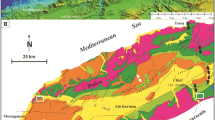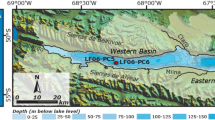Abstract
Hypereutrophic Upper Klamath Lake has been studied for almost 50 years to evaluate the nature, cause, and effects of its very productive waters. Mitigation of undesirable effects of massive cyanobacterial blooms requires understanding their modern causes as well as their history. Knowledge of the pre-settlement natural limnology of this system can provide guidelines for lake restoration and management of land and water use strategies to maximize the benefits of this aquatic resource. This investigation uses a paleolimnological approach to document the nature and chronology of limnological and biological changes in Upper Klamath Lake for the past 200 years, covering the time when the lake was first described until today. A 45-cm gravity core, dated by 210Pb and diatom correlations, was analyzed for diatoms, pollen, akinetes (resting spores) of the cyanobacterium Aphanizomenon flos-aquae, reworked tephra shards, and sediment magnetic characteristics. Pollen profiles show little vegetation change during this time. In contrast, diatoms indicative of increased nutrient fluxes (P and Si) increase moderately, coinciding with the settlement of the region by Euro-Americans. Numerous settlement activities, including draining of lake-margin marshes, upstream agriculture and timber harvest, road construction, and boat traffic, may have affected the lake. Magnetic properties and reworked tephra suggest riparian changes throughout the basin and increased lithogenic sediment delivery to the lake, especially after 1920 when the marshes near the mouth of the Williamson River were drained and converted to agricultural and pasture land. Drainage and channelization also decreased the ability of the marshes to function as traps and filters for upstream water and sediments. Akinetes of Aphanizomenon flos-aquae record progressive eutrophication of Upper Klamath Lake beginning in the 20th century and particularly after 1920 when lake-margin marsh reclamation more than doubled. The coincidence of limnological changes and human activities following European settlement suggests a major impact on the Upper Klamath Lake ecosystem, although ascribing specific limnological changes to specific human activities is difficult.
Similar content being viewed by others
References
Battarbee R.B. 1973. A new method for the estimation of absolute microfossil numbers, with reference especially to diatoms. Limnol. Oceanogr. 18: 647–653.
Bond C.E., Hazel C.R. and Vincent D. 1968. Relations of nuisance algae to fishes in Upper Klamath Lake. Terminal Report to FWPCA, Dept. of Fisheries and Wildlife, Oregon State University, 119 pp.
Bortleson G.C. and Fretwell M.O. 1993. A review of possible causes of nutrient enrichment and decline of endangered sucker populations in Upper Klamath Lake, Oregon. US Geological Survey Water Resources Investigations Report 93-4087, 24 pp.
Boyd M., Kirk S., Wiltsey M. and Kasper B. 2002. Upper Klamath Lake Drainage Total Maximum Daily Load (TMDL) and Water Quality Management Plan (WQMP). Oregon Department of Environmental Quality, Portland, Oregon, 188 pp.
Bradbury J.P. 1975. Diatom stratigraphy and human settlement in Minnesota. Geological Society of America, Special Paper 171, 74 pp.
Bradbury J.P. 1988. A climatic-limnologic model of diatom succession for paleolimnological interpretation of varved sediments at Elk Lake, Minnesota. J. Paleolim. 1: 115–131.
Bradbury J.P., Colman S.M. and Dean W.E. 2004. Limnological and climatic environments at Upper Klamath Lake, Oregon during the past 45,000 years. J. Paleolim. 31: 167–188 (this issue).
Brownell D.L. and Rinallo M.R. 1995. A selected bibliography of water related research in the Upper Klamath Basin, Oregon. US Geological Survey Open-File Report 95-285, 23 pp.
Colman S.M., Bradbury J.P., McGeehin J.P., Holmes C.W., Edginton D. and Sarna-Wojcicki A.M. 2004a. Chronology of sediment deposition in Upper Klamath Lake, Oregon. J. Paleolim. 31: 139–149 (this issue).
Colman S.M., Bradbury J.P. and Rosenbaum J.G. 2004. Paleolimnology and paleoclimate studies in Upper Klamath Lake, Oregon. J. Paleolim. 31: 129–138 (this issue).
Drew H.J. 1974. Early transportation on Klamath waterways. Klamath County Museum, Research Paper 6, 100 pp.
Eilers J.M., Kann J., Cornett J., Moser K., Armand St.A. and Gubala C.P. (in press). Recent Paleolimnology of Upper Klamath Lake, Oregon. Hydrobiologia.
Frémont J.C. 1845. Report of the exploring expedition to the Rocky Mountains in the year 1842 and to Oregon and California in the years 1843–1844. Goles and Seaton, Washington, DC.
Gasse F. 1986. East African diatoms — taxonomy, ecological distribution. Bibliotheca Diatomol. 11: 201 pp.
Gearheart R.A., Anderson J.K., George-Forbes M., Osburn M. and Oros D. 1995. Watershed strategies for improving water quality in Upper Klamath Lake, Oregon, vol. 1, Humboldt State University, California, 41 pp.
Grayson D.K. 1976. The Nightfire Island avifauna and the Altithermal. Nevada Archaeological Survey Research Paper # 6. University of Nevada, Reno, pp. 75–102.
Kann J. 1997. Ecology and water quality dynamics of a shallow hypereutrophic lake dominated by cyanobacteria (Aphanizomenon flos-aque). PhD dissertation, University of North Carolina, Chapel Hill, North Carolina, 110 pp.
Keen F.P. 1937. Climate cycles in eastern Oregon as indicated by tree rings. Monthly Weather Rev. 65: 175–188.
Laenen A. and LeTourneau A.P. 1996. Upper Klamath Lake nutrient loading study — Estimate of wind-induced resuspension of bed sediment during periods of low lake elevation. US Geological Survey Open-File Report 95-414, 11 pp.
Martin E.A. and Rice C.A. 1981. 210Pb geochronology and trace metal concentrations of sediments from Upper Klamath Lake and Lake Euwana, Oregon. Northwest Sci. 55(4): 269–289.
Miller R.F. and Rose J.A. 1995. Historic expansion of Juniperus occidentalis (western juniper) in southeast Oregon. Great Basin Nat. 55: 37–45.
Phinney H.K., Peek C.A. and McLachlan M.C. 1959. A survey of the phytoplankton problems in Klamath Lake. Oregon State University, Department of Biology, mimeograph, 52 pp.
Risley J.C. and Laenen A. 1998. Upper Klamath Lake basin nutrient loading study — Assessment of historic flows in the Williamson and Sprague Rivers. US Geological Survey Water Resources Investigations Report 98-4198, 22 pp.
Sanville W.D., Powers C.F. and Gahler A.R. 1974. Sediments and sediment-water nutrient interchange in Upper Klamath Lake, Oregon. US Environmental Protection Agency Report EPA-660/3-74-015, 45 pp.
Snyder D.T. and Morace J.L. 1997. Nitrogen and phosphorus loading from drained wetlands adjacent to Upper Klamath and Agency Lakes, Oregon. US Geological Survey Water-Resources Investigations Report 97-4059, 67 pp.
Thompson R. and Oldfield F. 1985. Environmental Magnetism. Allen and Unwin, London, 227 pp.
Tilman D., Kilham S.S. and Kilham P. 1982. Phytoplankton community ecology: the role of limiting nutrients. Annu. Rev. Ecol. Syst. 13: 349–372.
Author information
Authors and Affiliations
Corresponding author
Rights and permissions
About this article
Cite this article
Platt Bradbury, J., Colman, S.M. & Reynolds, R.L. The History of Recent Limnological Changes and Human Impact on Upper Klamath Lake, Oregon. Journal of Paleolimnology 31, 151–165 (2004). https://doi.org/10.1023/B:JOPL.0000019233.12287.18
Issue Date:
DOI: https://doi.org/10.1023/B:JOPL.0000019233.12287.18




